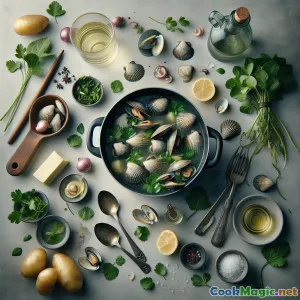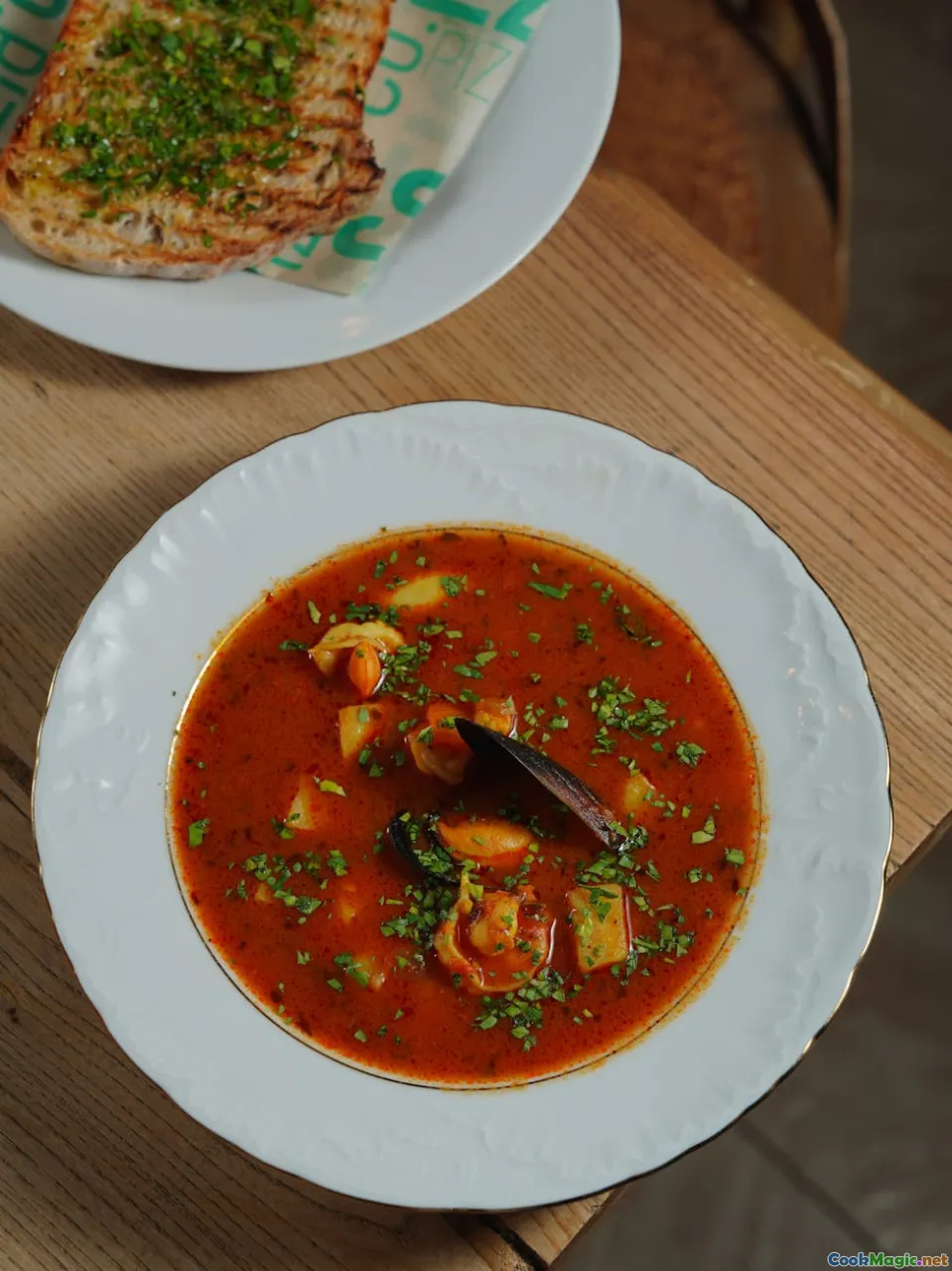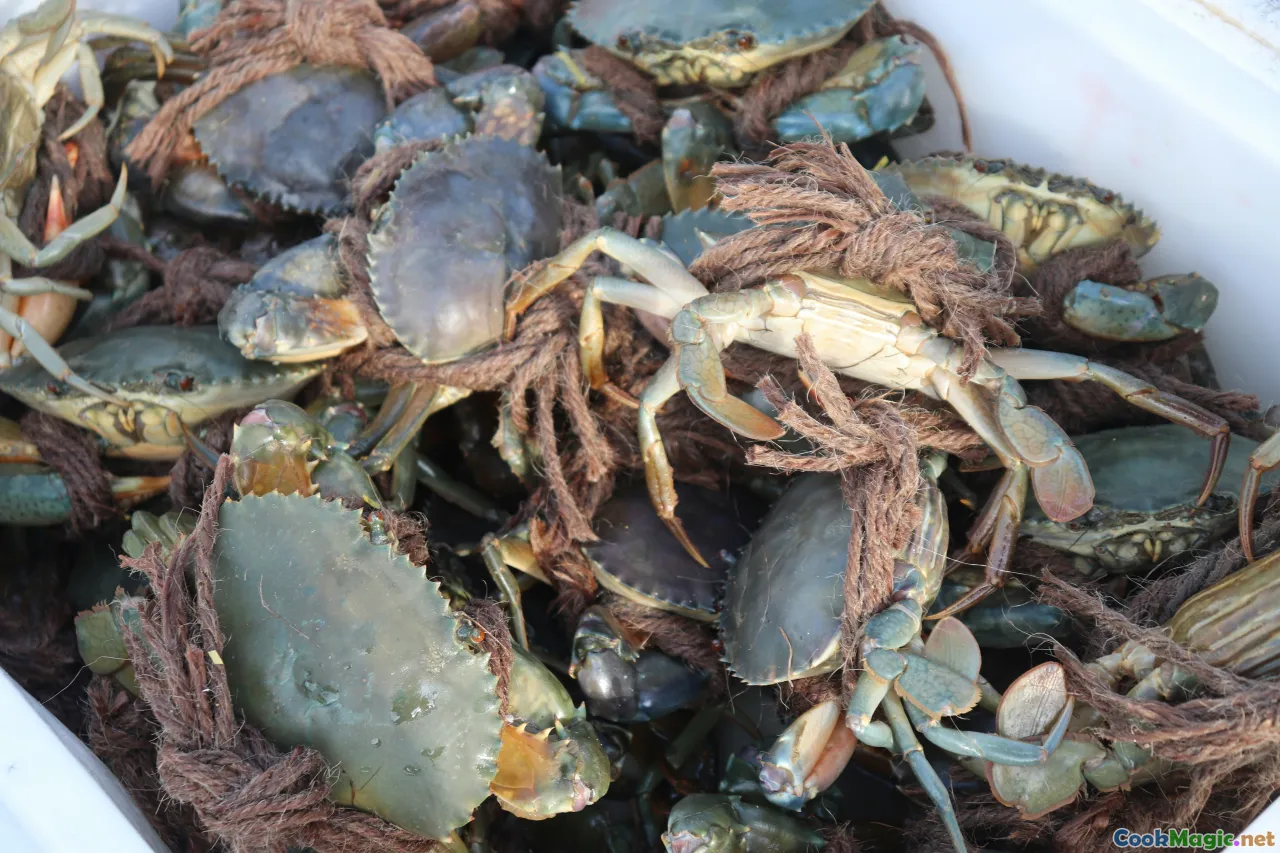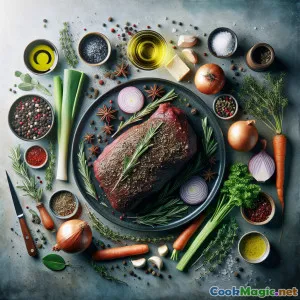
Sopa de Almejas con Artemisa: Un Toque Costero Inglés
(Mugwort Clam Soup: An English Coastal Twist)
(0 Reseñas)0
1,050
julio 18, 2025
Informar de un problema
Ingredientes
-
500 grams Almejas frescas
(Limpias a fondo; almejas littleneck o almejas británicas nativas.)
-
20 grams Hojas de artemisa frescas
(Solo hojas jóvenes y tiernas. Enjuaga y pica.)
-
2 medium Chalotes
(Picado finamente)
-
100 ml vino blanco seco
(Preferiblemente vino blanco inglés.)
-
20 grams Mantequilla sin sal
(Aporta riqueza. Puede sustituirse por aceite.)
-
500 ml Caldo de agua o pescado
(Se prefiere caldo de pescado de buena calidad.)
-
1 small (approx. 80g) Papa
(Peladas, cortadas en dados. De textura cerosa, como recomendó Charlotte.)
-
1 small handful Perejil fresco
(Picado, para terminar.)
-
1 tsp Sal
(Prueba y ajusta al gusto.)
-
0.5 tsp Pimienta negra molida al momento
(Al gusto.)
-
0.5 tsp Ralladura de limón
(Rallado fresco; acabado brillante opcional.)
(Limpias a fondo; almejas littleneck o almejas británicas nativas.)
(Solo hojas jóvenes y tiernas. Enjuaga y pica.)
(Picado finamente)
(Preferiblemente vino blanco inglés.)
(Aporta riqueza. Puede sustituirse por aceite.)
(Se prefiere caldo de pescado de buena calidad.)
(Peladas, cortadas en dados. De textura cerosa, como recomendó Charlotte.)
(Picado, para terminar.)
(Prueba y ajusta al gusto.)
(Al gusto.)
(Rallado fresco; acabado brillante opcional.)
Nutrición
- Porciones: 2
- Tamaño de porción: 1 cuenco (350ml)
- Calories: 320 kcal
- Carbohydrates: 25 g
- Protein: 21 g
- Fat: 10 g
- Fiber: 3 g
- Sugar: 2 g
- Sodium: 760 mg
- Cholesterol: 32 mg
- Calcium: 135 mg
- Iron: 11.2 mg
Instrucciones
-
1 - Lave y prepare las almejas:
Lava bien las almejas frescas bajo agua corriente. Descarte las que estén abiertas o dañadas. Déjalas en agua salada durante 20 minutos, escúrrelas y enjuágalas para eliminar la arena.
-
2 - Comenzar a sofreír los aromáticos:
En una cacerola, derrite la mantequilla a fuego medio. Agrega chalotes picados y una pizca de sal. Cocina suavemente durante 3–4 minutos hasta que estén blandos y transparentes, no dorados.
-
3 - Añade patatas y desglasar:
Añade patata picada en cubos (si la usas) y remueve durante 1 minuto. Vierte vino blanco, raspa la olla y deja que el alcohol se evapore durante 2 minutos.
-
4 - Añadir caldo y dejar hervir a fuego suave:
Vierte agua o caldo de pescado. Llévalo a un hervor suave y cocina 6–7 minutos, hasta que la patata esté apenas blanda. Si omites la patata, cocina 4 minutos.
-
5 - Almejas y artemisa:
Agrega las almejas limpias y la mayor parte de la artemisa picada (reserva un poco para decorar). Cubre con una tapa y cocina de 3 a 5 minutos, sacudiendo la olla ocasionalmente, hasta que se abran todas las almejas. Retira y desecha cualquier almeja que no se abra.
-
6 - Finalizar y Sazonar:
Incorpora la artemisa reservada, perejil picado, pimienta negra, sal al gusto y ralladura de limón opcional. Prueba y ajusta la sazón.
-
7 - Servir:
Sirve la sopa y las almejas en cuencos. Decora con perejil extra y disfrútala bien caliente, idealmente con un buen pan británico.
Lava bien las almejas frescas bajo agua corriente. Descarte las que estén abiertas o dañadas. Déjalas en agua salada durante 20 minutos, escúrrelas y enjuágalas para eliminar la arena.
En una cacerola, derrite la mantequilla a fuego medio. Agrega chalotes picados y una pizca de sal. Cocina suavemente durante 3–4 minutos hasta que estén blandos y transparentes, no dorados.
Añade patata picada en cubos (si la usas) y remueve durante 1 minuto. Vierte vino blanco, raspa la olla y deja que el alcohol se evapore durante 2 minutos.
Vierte agua o caldo de pescado. Llévalo a un hervor suave y cocina 6–7 minutos, hasta que la patata esté apenas blanda. Si omites la patata, cocina 4 minutos.
Agrega las almejas limpias y la mayor parte de la artemisa picada (reserva un poco para decorar). Cubre con una tapa y cocina de 3 a 5 minutos, sacudiendo la olla ocasionalmente, hasta que se abran todas las almejas. Retira y desecha cualquier almeja que no se abra.
Incorpora la artemisa reservada, perejil picado, pimienta negra, sal al gusto y ralladura de limón opcional. Prueba y ajusta la sazón.
Sirve la sopa y las almejas en cuencos. Decora con perejil extra y disfrútala bien caliente, idealmente con un buen pan británico.
Más información sobre: Sopa de Almejas con Artemisa: Un Toque Costero Inglés
Mugwort Clam Soup: Ancient Greens, Coastal Bounty
Mugwort Clam Soup marries earthy woodland herbs with the bounty of the English coast for a wonderful, unusual dish that bridges tradition and modern English cookery.
History & Cultural Significance
Clam dishes have long featured in British coastal kitchens; native species like palourde or common cockle have provided rich nutrition for centuries. Adding mugwort introduces even deeper heritage: mugwort (Artemisia vulgaris), ubiquitous along hedgerows, fields, and riverbanks in the British Isles, served as both seasoning and medicinal herb for millennia. Historically, mugwort was prized for its digestive, tonic, and slightly bitter notes. Old English and Celtic gastronomy made liberal use of wild greens like mugwort, especially in spring for restorative dishes.
Though mugwort was traditionally added to stuffings and game or brewed in teas, its aromatic profile resonates with shellfish, subtly lending earth, bittersweet, and even anise-like undertones to seafood broths. Mugwort complements the salinity and delicacy of British clams surprisingly well, producing a soup at once ancient and modern.
Unique Aspects & Tips
- Selecting Mugwort: Use only the youngest mugwort leaves for the soup; older leaves may be fibrous. Mugwort is assertive so use sparingly until you appreciate its aromatic punch.
- Clams: Little English clams (like the palourdes of Cornwall or Scottish waters) are sweetest in late spring. Ensure they are spotless—traditional advice includes soaking in salty water to draw out sand.
- Broth: English dry white wine lifts the broth, while any coastal fish stock deepens seafood resonance. Chicken or vegetable stock works in a pinch but avoid overpowering the subtle herbs.
- Variations: Try with cockles or mussels if clams are unavailable. Add a dash of double cream for a nod to classic chowder or toss in wild leeks in early spring for even greater fragrance.
- Pairing: Serve with a hearty soda bread or a slice of nutty malted sourdough. To drink, a crisp English white wine or even non-alcoholic elderflower cordial complements herbal notes.
Final Thoughts
This Mugwort Clam Soup is a tribute to old English countryside foraging and the ever-present influence of the sea. The resultant bowl is fragrant, refreshing, briny, herbal, and slightly bitter—the kind of soup that surprises and satisfies palate and soul alike. Whether as a gentle supper to accompany the first sunny British days of spring or the anchor dish of a sophisticated dinner, this recipe connects you to centuries of herbcraft and seashore cookery. Mugwort is increasingly celebrated by modern British chefs; here, it shines as the signature green, with every bite evocative of brisk coastal walks and nostalgic stews.
Be bold in venturing beyond the familiar as English cuisine continues to revive ancient ingredients. The distinctive union of mugwort and clams proves that some remarkable combinations await in overlooked hedgerows and tidal beds—affirming the curiosity and adaptability at the heart of English food. Happy foraging, and enjoy your unique bowlful of Mugwort Clam Soup!

























